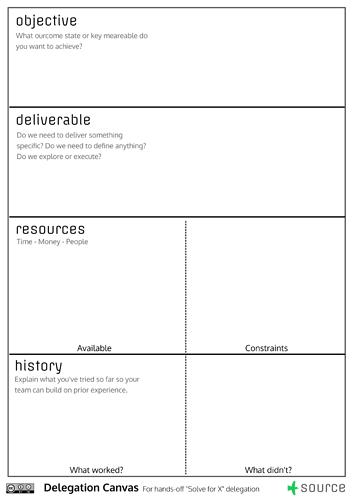Purpose
Fixer Sessions allow a single Challenger to have a particular challenge solved by a small group of peers (Fixers). In doing so, the Challenger also learns how the Fixers approach the challenge, so learn to broaden their own mindset. The Challenger also learns how to delegate to leaders and highly-responsible people who respond better with “Solve for X” objectives than task-based micro-management.
Preparation
Ask the Challenger to choose a maximum of 4 people as their Fixers, ideally those with a diverse range of skills and approaches. It is advisable to keep this to a single group of 4 Fixers, but if this is being run in larger groups, separate the Fixers into teams of 4 max.
Hang a poster-sized Delegation Canvas, and give the Challenger sticky notes and a felt-tip pen.
The Format
Setup (2 minutes)
Describe the purpose and phases of the Fixer Session. Make sure to let everyone know the phases, the time for each phase, and that once the Fixer team starts, the Challenger can no longer speak!
Use a timer visible to everyone to limit each phase.
Delegation Phase (10 minutes)
Help the Challenger present, covering the Delegation Canvas from top to bottom. Encourage them to be practical:
- scope the challenge so it can be completed easily within the time allotted
- explain the history and resources in a practical way, where the Fixers can visualise what they have to work with
- help choose a final deliverable that the Challenger can take use to take immediate action
If they are done before the 10 minutes is complete, use the extra time to allow for more clarification questions.
Clarification Questions Phase(10 minutes)
Open the floor to the Fixers to ask questions to clarify their task. Strictly discourage the Fixers from starting down a path to a specific solution. If they do, help them frame open-ended questions about the scope or limits of possible solutions. Their job is to make sure they have the information they need, in case the first solutions that come to their mind are invalid or not viable.
Solution Phase (60 minutes)
The Fixer team now has time to come up with the deliverable. During this time, the Challenger must remain completely silent and can’t respond to questions. They should be encouraged to observe, to learn how their Fixers think and how their delegation affects the teams.
Faciliation Tips:
- Don’t manage or lead the Fixer team. Set expectations that they’re professionals and can manage themselves.
- Encourage the team to start creating the deliverable in the first 10 minutes. It’s better to start and improve than wait too long and rush.
- Remind the Fixers to refer back to the Delegation Canvas periodically so they stay on track.
Optional Exception: you can allow the Challenger two interventions during the Solution Phase where they can speak for 30 seconds. They must use them wisely! Encourage them to only intervene if the Fixers have been clearly off track for a few minutes and are missing key information that should have been included in the Delegation Phase.
Feedback Phase (10 minutes)
The Challenger can now speak again, and can give feedback about the deliverable and lessons learned. Give them a minute or two and then open up to discussion with the whole group.
If working with several Fixer Teams, ask each team to present for 60 seconds, and then give the remaining time for The Challenger to respond.
To wrap up, ask the Challenger to express how much time or effort the Fixers saved them, if any, and perhaps their next steps. This will allow the Fixers to see how well they really did.

